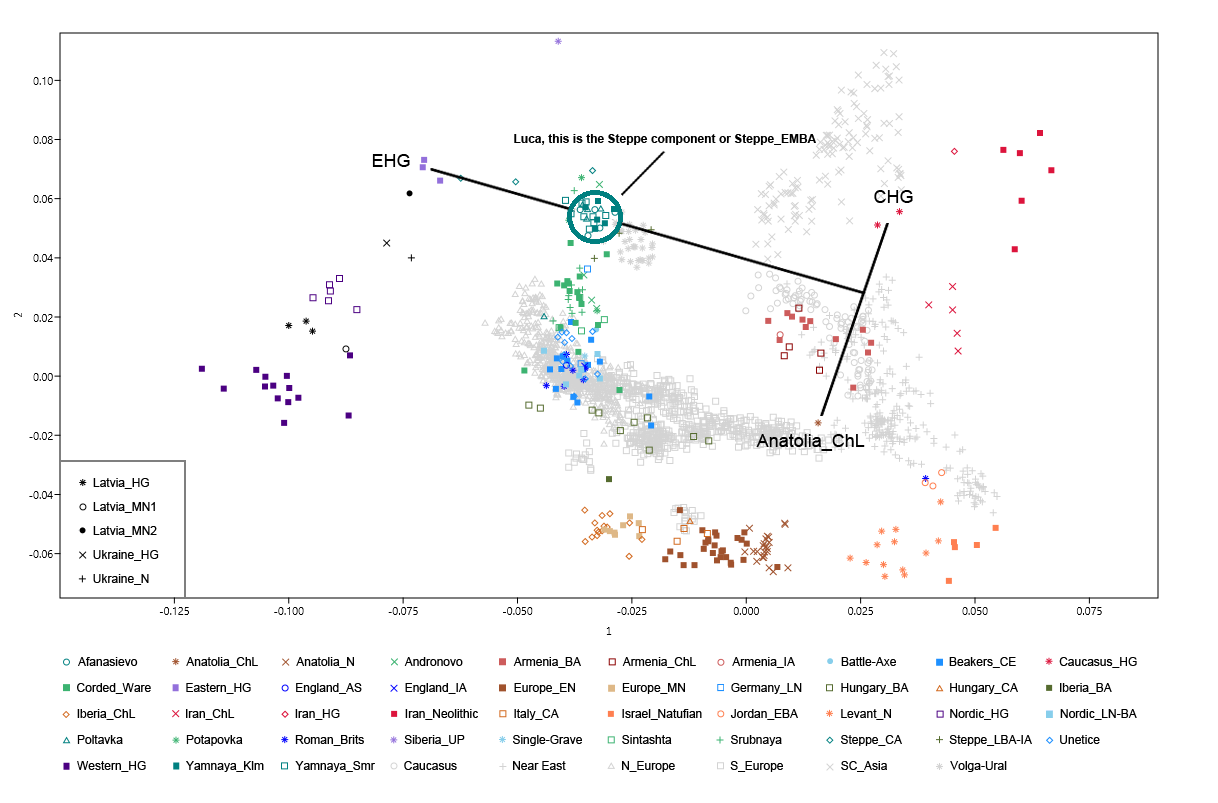Angela
Elite member
- Messages
- 21,823
- Reaction score
- 12,329
- Points
- 113
- Ethnic group
- Italian
The long knives are out and the paper isn't even available yet. These aren't light weights we're talking about here. How can you "deconstruct" an analysis when you haven't even read their "proofs" yet?
Oh well, fun and games.
"A Pre-Existing Isolation by Distance Gradient in West Eurasia May Partly Account for the Observed “Steppe” Component in Europe
Luca Pagani, Lehti Saag, Anto Aasa, Flora Jay, Mait Metspalu
Estonian Biocentre, Riia 23b, 51010 Tartu,
Department of
Geography, University of Tartu, 51010 Tartu, Estonia;
LRI, Paris-Sud University, CNRS UMR 8623, Orsay, France
It has been proposed that modern European populations can be modelled, by and large, as a three-way mixture of Hunter-Gatherer, Anatolian Neolithic and Steppe components that took place after 6kya (Haak et al. 2015, Allentoft et al. 2015). Particularly the pre-existing Hunter-Gatherer are thought to have admixed with incoming Early Neolithic people from Anatolian and, subsequently, with people carrying a “Steppe” component from the East. These people were likely bearing the so called Yamnaya and/or Corded-Ware cultures, and their initial impact of the European gene pool was estimated to be as high as 75% (Haak et al. 2015).
However ancient DNA samples from East European and Caucasian Hunter-Gatherers as well as from Early Iranian Neolithic, dating from before the Yamnaya expansion, already show signs of this so called “Steppe” component (Lazaridis et al. 2016). Such an observation is compatible with the presence of a pre-existing genetic gradient ranging from Caucasus/Iran all the way to Europe, which likely formed through isolation by distance over thousands of years.
Here we show that such a gradient, defined as decrease of “steppe” component with distance from Iran, can be inferred from ancient samples pre-dating the Yamnaya expansion (r^2 = 0.93).
When analysed in the light of this gradient, later ancient and modern samples from Europe still display an excess of Steppe component, however this excess is less pronounced than previously estimated. Additionally we found that, of the analysed samples, modern South Asians show the highest excess of “steppe” component, pointing to the documented, recent links between the Caucasus/Iran populations and the South Asian peninsula."
I don't know if what they're labeling as the "steppe" component is CHG. If it is, couldn't some of this excess CHG have been pre-existing in South Asia? Or perhaps they know something about South Asian ancient dna which hasn't been published.
I also wonder if they have some new "steppe" samples which have been analyzed.
They seem to also be linking this "steppe" component with Iran, which may be part of the reason that it has aroused such ire already.
Oh well, fun and games.
"A Pre-Existing Isolation by Distance Gradient in West Eurasia May Partly Account for the Observed “Steppe” Component in Europe
Luca Pagani, Lehti Saag, Anto Aasa, Flora Jay, Mait Metspalu
Estonian Biocentre, Riia 23b, 51010 Tartu,
Department of
Geography, University of Tartu, 51010 Tartu, Estonia;
LRI, Paris-Sud University, CNRS UMR 8623, Orsay, France
It has been proposed that modern European populations can be modelled, by and large, as a three-way mixture of Hunter-Gatherer, Anatolian Neolithic and Steppe components that took place after 6kya (Haak et al. 2015, Allentoft et al. 2015). Particularly the pre-existing Hunter-Gatherer are thought to have admixed with incoming Early Neolithic people from Anatolian and, subsequently, with people carrying a “Steppe” component from the East. These people were likely bearing the so called Yamnaya and/or Corded-Ware cultures, and their initial impact of the European gene pool was estimated to be as high as 75% (Haak et al. 2015).
However ancient DNA samples from East European and Caucasian Hunter-Gatherers as well as from Early Iranian Neolithic, dating from before the Yamnaya expansion, already show signs of this so called “Steppe” component (Lazaridis et al. 2016). Such an observation is compatible with the presence of a pre-existing genetic gradient ranging from Caucasus/Iran all the way to Europe, which likely formed through isolation by distance over thousands of years.
Here we show that such a gradient, defined as decrease of “steppe” component with distance from Iran, can be inferred from ancient samples pre-dating the Yamnaya expansion (r^2 = 0.93).
When analysed in the light of this gradient, later ancient and modern samples from Europe still display an excess of Steppe component, however this excess is less pronounced than previously estimated. Additionally we found that, of the analysed samples, modern South Asians show the highest excess of “steppe” component, pointing to the documented, recent links between the Caucasus/Iran populations and the South Asian peninsula."
I don't know if what they're labeling as the "steppe" component is CHG. If it is, couldn't some of this excess CHG have been pre-existing in South Asia? Or perhaps they know something about South Asian ancient dna which hasn't been published.
I also wonder if they have some new "steppe" samples which have been analyzed.
They seem to also be linking this "steppe" component with Iran, which may be part of the reason that it has aroused such ire already.



#/media/File%3AHaplogroup_J_(Y-DNA).svg)